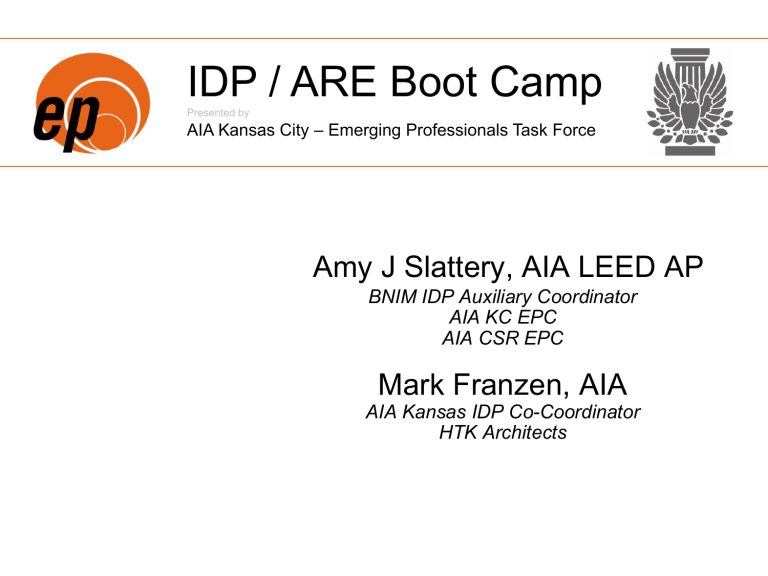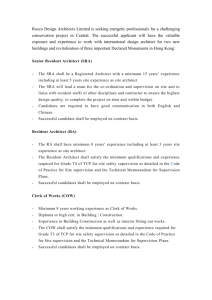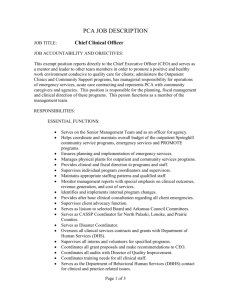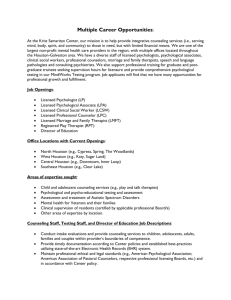Setting B - AIA Kansas City

IDP / ARE Boot Camp
Presented by
AIA Kansas City
– Emerging Professionals Task Force
Amy J Slattery, AIA LEED AP
BNIM IDP Auxiliary Coordinator
AIA KC EPC
AIA CSR EPC
Mark Franzen, AIA
AIA Kansas IDP Co-Coordinator
HTK Architects
What Gives?
Why?
Intern Survey Question:
Why do you want to be licensed?
•Because it is something I want to do.
•Because it is traditionally done.
•So that I can begin doing my own projects
•Test is required to have the “title”, can’t practice without license
Mentor Survey Question:
Why do you think it is important to be licensed?
•To practice architecture, you must be licensed, according to law.
•Licensure is the measure of meeting a professional level of knowledge
•Confidence
•Self-promotion
•Value to the firm – billing rate higher
•To earn deserving respect from clients, peers, and consultants
•Ensures Public Safety
Would you hire a Lawyer…?
Would you work with an Engineer…?
Would you go to a Doctor…?
“Just because you brush your teeth…doesn’t make you a Dentist.”
Architect Attrition rate:
4 : 1
Source: AIA National Associates Committee
Average Age =
55
45
% AIA Members >
55
25
% Retire within
4
years
77
% of AIA KC Licensed
Source: AIA National Associates Committee
The industry is sending out an…
Education
Education Requirements
• NAAB Accredited Degree is required as
Primary means of Satisfying Education requirement in 49 of 54 Member Boards.
• Kansas requires an NAAB-Accredited degree
• Missouri requires an NAAB-Accredited degree, but will allow those without one to apply for examination if they apply prior to
January 1, 2012
Experience
What is IDP?
A tool to verify experience
The purpose of the Intern Development
Program (IDP) is to train and develop competent architects who are prepared to practice architecture independently upon registration, and support the National Council of
Architectural Registration Boards’ mission to protect the health, safety, and welfare of the public .
A training requirement in most jurisdictions
The IDP is designed to make your internship a meaningful experience by exposing you to many aspects of the profession so that you are prepared to practice architecture independently.
Stay Fresh!
When can you start?
1. Three years in an NAAB-accredited professional degree program
2. The third year of a four year preprofessional degree program in architecture accepted for direct entry to a two-year
NAABaccredited professional master’s degree program
3. One year in NAAB-accredited professional master’s degree program following receipt of a non-professional degree
Full-time
32
hours
8
Weeks
Part-time
15
Hrs/Wk
8
Weeks
A
Training Settings Maximum
Setting A: Under the direct supervision of a licensed architect in a comprehensive architecture practice
Setting B: Under the direct supervision of a licensed architect in a non-comprehensive architecture practice
Setting C: Firm outside the U.S. or Canada under a foreign licensed architect
Setting D: Experience related to architecture under the supervision of a licensed engineer or landscape architect
Setting E: Activities in design/construction of built environment under direct supervision of one experienced in activity (not in Category A or B)
Setting F: Full-time teaching or research in a NAAB or CACB-accredited program (Category D only)
Setting FF: Performing professional and community service when not in settings described in A through F
(Training Area 16 only)
No Limit
465
235
235
117
245
10
A
B
Training Settings Maximum
Setting A: Under the direct supervision of a licensed architect in a comprehensive architecture practice
Setting B: Under the direct supervision of a licensed architect in a non-comprehensive architecture practice
Setting C: Firm outside the U.S. or Canada under a foreign licensed architect
Setting D: Experience related to architecture under the supervision of a licensed engineer or landscape architect
Setting E: Activities in design/construction of built environment under direct supervision of one experienced in activity (not in Category A or B)
Setting F: Full-time teaching or research in a NAAB or CACB-accredited program (Category D only)
Setting FF: Performing professional and community service when not in settings described in A through F
(Training Area 16 only)
No Limit
465
235
235
117
245
10
A
B
C
Training Settings Maximum
Setting A: Under the direct supervision of a licensed architect in a comprehensive architecture practice
Setting B: Under the direct supervision of a licensed architect in a non-comprehensive architecture practice
Setting C: Firm outside the U.S. or Canada under a foreign licensed architect
Setting D: Experience related to architecture under the supervision of a licensed engineer or landscape architect
Setting E: Activities in design/construction of built environment under direct supervision of one experienced in activity (not in Category A or B)
Setting F: Full-time teaching or research in a NAAB or CACB-accredited program (Category D only)
Setting FF: Performing professional and community service when not in settings described in A through F
(Training Area 16 only)
No Limit
465
235
235
117
245
10
A
B
C
D
Training Settings Maximum
Setting A: Under the direct supervision of a licensed architect in a comprehensive architecture practice
Setting B: Under the direct supervision of a licensed architect in a non-comprehensive architecture practice
Setting C: Firm outside the U.S. or Canada under a foreign licensed architect
Setting D: Experience related to architecture under the supervision of a licensed engineer or landscape architect
Setting E: Activities in design/construction of built environment under direct supervision of one experienced in activity (not in Category A or B)
Setting F: Full-time teaching or research in a NAAB or CACB-accredited program (Category D only)
Setting FF: Performing professional and community service when not in settings described in A through F
(Training Area 16 only)
No Limit
465
235
235
117
245
10
A
B
C
D
E
Training Settings Maximum
Setting A: Under the direct supervision of a licensed architect in a comprehensive architecture practice
Setting B: Under the direct supervision of a licensed architect in a non-comprehensive architecture practice
Setting C: Firm outside the U.S. or Canada under a foreign licensed architect
Setting D: Experience related to architecture under the supervision of a licensed engineer or landscape architect
Setting E: Activities in design/construction of built environment under direct supervision of one experienced in activity (not in Category A or B)
Setting F: Full-time teaching or research in a NAAB or CACB-accredited program (Category D only)
Setting FF: Performing professional and community service when not in settings described in A through F
(Training Area 16 only)
No Limit
465
235
235
117
245
10
A
B
C
D
E
F
Training Settings Maximum
Setting A: Under the direct supervision of a licensed architect in a comprehensive architecture practice
Setting B: Under the direct supervision of a licensed architect in a non-comprehensive architecture practice
Setting C: Firm outside the U.S. or Canada under a foreign licensed architect
Setting D: Experience related to architecture under the supervision of a licensed engineer or landscape architect
Setting E: Activities in design/construction of built environment under direct supervision of one experienced in activity (not in Category A or B)
Setting F: Full-time teaching or research in a NAAB or CACB-accredited program (Category D only)
Setting FF: Performing professional and community service when not in settings described in A through F
(Training Area 16 only)
No Limit
465
235
235
117
245
10
A
B
C
D
E
F
FF
Training Settings Maximum
Setting A: Under the direct supervision of a licensed architect in a comprehensive architecture practice
Setting B: Under the direct supervision of a licensed architect in a non-comprehensive architecture practice
Setting C: Firm outside the U.S. or Canada under a foreign licensed architect
Setting D: Experience related to architecture under the supervision of a licensed engineer or landscape architect
Setting E: Activities in design/construction of built environment under direct supervision of one experienced in activity (not in Category A or B)
Setting F: Full-time teaching or research in a NAAB or CACB-accredited program (Category D only)
Setting FF: Performing professional and community service when not in settings described in A through F
(Training Area 16 only)
No Limit
465
235
235
117
245
10
16
Sections
4
Categories
8
Hrs =
1
Credit
IDP Breakdown
1. Programming
2. Site and Environmental Analysis
3. Schematic Design
4. Engineering Systems Coordination
5. Building Cost Analysis
6. Code Research
7. Design Development
8. Construction Documents
9. Specifications & Material Research
10. Document Checking and Coord.
11. Bidding and Contract Negotiation
12. CA Office
13. CA Field
14. Project Management
15. Office Management
16. Professional and Community Service
15
10
10
15
15
15
10
10
Minimum
10
10
15
15
10
15
40
135
Maximum
“
“
“
“
“
“
“
“
“
None
“
“
465
“
235
117
Total
465
A
Design & Construction Documents
1. Programming
2. Site and Environmental Analysis
3. Schematic Design
4. Engineering Systems Coordination
5. Building Cost Analysis
6. Code Research
7. Design Development
8. Construction Documents
9. Specifications & Material Research
10. Document Checking and Coord.
11. Bidding and Contract Negotiation
12. CA Office
13. CA Field
14. Project Management
15. Office Management
16. Professional and Community Service
15
10
10
15
15
15
10
10
Minimum
10
10
15
15
10
15
40
135
Maximum
“
“
“
“
“
“
“
“
“
None
“
“
465
“
235
117
Total
465
A
B
Construction Contract Administration
1. Programming
2. Site and Environmental Analysis
3. Schematic Design
4. Engineering Systems Coordination
5. Building Cost Analysis
6. Code Research
7. Design Development
8. Construction Documents
9. Specifications & Material Research
10. Document Checking and Coord.
11. Bidding and Contract Negotiation
12. CA Office
13. CA Field
14. Project Management
15. Office Management
16. Professional and Community Service
15
10
10
15
15
15
10
10
Minimum
10
10
15
15
10
15
40
135
Maximum
“
“
“
“
“
“
“
“
“
None
“
“
465
“
235
117
Total
465
A
B
C
Management
1. Programming
2. Site and Environmental Analysis
3. Schematic Design
4. Engineering Systems Coordination
5. Building Cost Analysis
6. Code Research
7. Design Development
8. Construction Documents
9. Specifications & Material Research
10. Document Checking and Coord.
11. Bidding and Contract Negotiation
12. CA Office
13. CA Field
14. Project Management
15. Office Management
16. Professional and Community Service
15
10
10
15
15
15
10
10
Minimum
10
10
15
15
10
15
40
135
Maximum
“
“
“
“
“
“
“
“
“
None
“
“
465
“
235
117
Total
465
A
B
C
D
Related Activities
1. Programming
2. Site and Environmental Analysis
3. Schematic Design
4. Engineering Systems Coordination
5. Building Cost Analysis
6. Code Research
7. Design Development
8. Construction Documents
9. Specifications & Material Research
10. Document Checking and Coord.
11. Bidding and Contract Negotiation
12. CA Office
13. CA Field
14. Project Management
15. Office Management
16. Professional and Community Service
15
10
10
15
15
15
10
10
Minimum
10
10
15
15
10
15
40
135
Maximum
“
“
“
“
“
“
“
“
“
None
“
“
465
“
235
117
Total
465
Supplemental
Education
Up to 235 Learning Units
• Emerging Professionals Companion
• AIA CEU’s .25 TU per CE8
• LEED Accreditation – 5 TU’s
• Before or after 1 July 2009
• Masters Credits Count (Up to 117)
465 + 235 =
700
117
max “other”
8
= 1
700x8 =
5600
hr
700/235 =
3
yr
4.8
yrs for IDP
6.7
yrs for ARE
Source: 2005 Internship and Career Survey
How?
How to Get Started
•Apply for Council Record, (Online)
•Submit Transcript
•Identify Daily Supervisor
•Identify a Mentor
•Keep record of training hours,
(NCARB Spreadsheet)
•Submit hours, e-EVR
•Track hours on My NCARB Record
Online
App
.
Tracking
Tracking
e-EVR
All electronic by
July 1, 2009
e-EVR
Supervisor
Identify a Daily Supervisor
•Must be licensed in the State which experience is earned
•Should be familiar with state licensing requirements and with IDP Guidelines
•Ideally supervises and assesses intern’s work on a daily basis
•Provides reasonable opportunities for intern to gain experience in IDP training categories and expertise areas
•Meet regularly with the intern to review progress and to certify (sign) intern's documentation of training activities
•Encourage intern participation in seminars and other supplementary education activities or resources
•Confer, if necessary, with the intern's mentor
Mentor
Identify a Mentor
• Licensed architect, preferably outside firm and can be outside jurisdiction of intern’s firm
• Supervisor may be mentor, but not best scenario for intern
• Should be familiar with state licensure requirements and IDP Guidelines
• Meet regularly (at least quarterly) with intern to review progress and to acknowledge (sign) intern's training activities
• Suggest supplementary education activities and confer, if necessary, with the intern's supervisor
• Provide guidance to enhance intern's professional growth
• Mentoring Essentials training program on www.aia.org
$$$
Fee Structure
• Application for NCARB Council Record
• $285 includes 3 years maintenance and 1 transmittal to Member Board
• Students and recent graduates may pay
$100 fee at application and pay remaining
$185 for transmittal of Council Record to
Member Board
• Transmittal to NCARB Member Board
• First transmittal fee part of initial $285 total application fee
• $300 each for additional transmittals to
NCARB Member Boards
• Application for ARE to NCARB Member Board
•Varies per Member Board
• Annual Maintenance $60 during Process of taking
$$$
Fee Structure
• Application for NCARB Certificate after passing ARE
• $175 – However Fee is waived if Annual
Maintenance fee of $60/yr has been kept current during ARE Process
• Annual State License renewal
• Varies per Member Board
• Annual NCARB Certificate Renewal
• $190 per year
• $75 per year for first three years if Annual
Maintenance fee of $60/yr has been kept current during ARE Process
Tips
Tips to Get You Ahead of the Game
• Early Enrollment Pays - $100 to enroll if done within first 6 months of graduation
•
Pre-graduation hours can be submitted from 3rd year, up to 117 credits
• Watch your hours, and be creative in allocating them.
•
Prerequisite hours not met
• Keep up with tracking your hours
6-month rule
6-Month Rule
• Requires interns establishing a new NCARB
Record on or after July 1, 2009 to submit training reports of no more than six-months duration.
• 2 month grace period to report previous 6 months of experience.
• 1 Year Grace Period for current IDP’ers
• July 1, 2010, the “Six-Month Rule” will apply to all interns.
HELP!
Available Resources
•NCARB website < www.ncarb.org
>
•Spread sheet
< http://www.ncarb.org/IDP/idpworkbook.html
>
•EPC < http://www.epcompanion.org/ >
•IDP FAQ < http://www.ncarb.org/IDP/idpfaq.html
>
IDP+ARE Concurrent
Each jurisdiction is different
Those who allow ARE before IDP completion:
Yes
AL AZ CA DC FL IA IN KS KY LA MA MO
MS MT NE NM OH OK OR SC TN TX UT
VT WI WV WY
No
AK AR CO CT DE GA GU HI ID ME MI MN
NC NJ NV NY PA RI VA
Must complete educational requirement before starting the tests
Graphic
Sections in Recommended Order
1. Schematic Design
2. Site Planning & Design
3. Building Systems
4. Structural Systems
5. Construction Documents & Services
6. Building Design & Construction Systems
7. Programming, Planning & Practice
Graphic
Math
Sections in Recommended Order
1. Schematic Design
2. Site Planning & Design
3. Building Systems
4. Structural Systems
5. Construction Documents & Services
6. Building Design & Construction Systems
7. Programming, Planning & Practice
Graphic
Math
Core
Sections in Recommended Order
1. Schematic Design
2. Site Planning & Design
3. Building Systems
4. Structural Systems
5. Construction Documents & Services
6. Building Design & Construction Systems
7. Programming, Planning & Practice
How?
How do I get started?
•Request Record Transmittal
•Submit Record to State Board w/ NCARB fee
•Obtain Testing Number
•Sign-up at Prometric Website
$$$
Fee Structure
•Each exam in 4.0 is $170
•$35 rescheduling fee
ARE Pass Rates by Division
Source: ncarb.org
Tips
Things That Slow You Down
• Experience based test, not book knowledge
• Remember your old study habits
• Procrastination!
• 6 month waiting period if fail test
• Annual Maintenance of NCARB Record,
$60 (Pay now or Pay Later), Online
Payment
• Obtain Reciprocity and maintain a council record when are finished, it will help in obtaining licensure in other states.
Rolling
Clock
Rolling Clock
• Starts January 1, 2006
• 5 years to complete all the sections
• Starts from the date of your first test
HELP!
Recommended Study Materials
Study Guides
• Kaplan Study Materials
• Ballast Study Materials
• Archiflash Flash Cards
• NCARB Study guides
Books
• Solutions, by Norman K. Dorf
• MEEB, Stein Reynolds
• Architectural Graphic Standards,
• Building Construction Illustrated, Ching
• LEED Study Guide
• AIA Architects Handbook of Professional
Practice
Software
• NCARB Practice Software
• Kaplan Test Bank Practice Tests
HELP!
Recommended Study Materials
Alternate Reference
• Thaddeus Cheat Sheet
• FEMA guides (Lat forces) on areforum.org ftp
• Sample AIA contract Documents, B141,
A201, C141
Online
• www.areforum.org
• ARE forum ftp site
• AIA National Emerging Professionals
• www.arcitrack.org
• ARE FAQ on NCARB Website
• AIA Houston Study Sessions
• AIA Tampa Study Sessions
• Boston Society of Architects
We don’t want LEGO People
Keep the Apprentice-Mentorship relationship alive!
Grow up and out of the system…become a mentor




